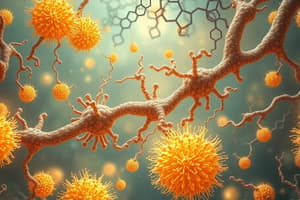Podcast
Questions and Answers
What specifically happens to an enzyme's structure during denaturation?
What specifically happens to an enzyme's structure during denaturation?
- The enzyme's active site is deformed and loses its specific shape. (correct)
- The primary structure of the enzyme is changed.
- The enzyme's tertiary structure is disrupted.
- The enzyme's quaternary structure is disrupted.
What is the role of enzymes in metabolic reactions?
What is the role of enzymes in metabolic reactions?
- Enzymes act as substrates in metabolic reactions.
- Enzymes speed up metabolic reactions by lowering the activation energy. (correct)
- Enzymes slow down metabolic reactions by increasing the activation energy.
- Enzymes provide the energy needed for metabolic reactions to occur.
Which of the following factors can directly affect the rate of a chemical reaction catalyzed by an enzyme?
Which of the following factors can directly affect the rate of a chemical reaction catalyzed by an enzyme?
- The type of solvent used in the reaction.
- The presence of a non-competitive inhibitor.
- The pH of the solution. (correct)
- The concentration of the product.
Why is it important for enzymes to be specific to their substrates?
Why is it important for enzymes to be specific to their substrates?
What is the effect of increasing the substrate concentration on the rate of an enzyme-catalyzed reaction?
What is the effect of increasing the substrate concentration on the rate of an enzyme-catalyzed reaction?
What is the correct relationship between temperature and the rate of an enzyme-catalyzed reaction?
What is the correct relationship between temperature and the rate of an enzyme-catalyzed reaction?
Which of the following is NOT a factor that can affect the rate of an enzyme-catalyzed reaction?
Which of the following is NOT a factor that can affect the rate of an enzyme-catalyzed reaction?
How does a competitive inhibitor affect the rate of an enzyme-catalyzed reaction?
How does a competitive inhibitor affect the rate of an enzyme-catalyzed reaction?
Which of the following is an example of a catabolic reaction?
Which of the following is an example of a catabolic reaction?
What is the role of activation energy in chemical reactions?
What is the role of activation energy in chemical reactions?
Which of these correctly describes an endothermic reaction?
Which of these correctly describes an endothermic reaction?
Which of the following is a reactant in the process of photosynthesis?
Which of the following is a reactant in the process of photosynthesis?
How does the law of conservation of energy apply to metabolic reactions?
How does the law of conservation of energy apply to metabolic reactions?
Which type of reaction releases energy into the surroundings?
Which type of reaction releases energy into the surroundings?
Why are chemical reactions essential for life?
Why are chemical reactions essential for life?
Which of the following statements is true about metabolism?
Which of the following statements is true about metabolism?
Flashcards
Cellular Respiration
Cellular Respiration
The process of converting chemical energy in sugar into ATP using oxygen.
Exothermic Reaction
Exothermic Reaction
A chemical reaction that releases energy, often in the form of heat.
Enzymes
Enzymes
Proteins that act as catalysts to speed up metabolic reactions by lowering activation energy.
Active Site
Active Site
Signup and view all the flashcards
Denaturation
Denaturation
Signup and view all the flashcards
Factors Affecting Reaction Rate
Factors Affecting Reaction Rate
Signup and view all the flashcards
Competitive Inhibitor
Competitive Inhibitor
Signup and view all the flashcards
Induced Fit Model
Induced Fit Model
Signup and view all the flashcards
Metabolism
Metabolism
Signup and view all the flashcards
Catabolic Reactions
Catabolic Reactions
Signup and view all the flashcards
Anabolic Reactions
Anabolic Reactions
Signup and view all the flashcards
Activation Energy
Activation Energy
Signup and view all the flashcards
Reactants
Reactants
Signup and view all the flashcards
Products
Products
Signup and view all the flashcards
Endothermic Reactions
Endothermic Reactions
Signup and view all the flashcards
Study Notes
Enzymes and Biochemical Reactions
- Biochemical reactions are controlled by enzymes, which are primarily proteins.
- Enzymes speed up biochemical reactions by lowering the activation energy, making reactions proceed faster.
- Enzymes are catalysts, meaning they speed up reactions without being permanently altered.
- Enzymes are specific in their action, binding to a specific substrate (reactant) through an active site.
- The active site’s shape is influenced by the substrate, creating an induced fit and ensuring a precise interaction between the enzyme and substrate.
- Enzymes can either break bonds in a substrate to form products or make bonds between substrates to form one product.
- Enzymes are not changed during a reaction and can be repeatedly used.
- Enzymes are critical to life processes and vital to virtually all organisms.
Metabolism
- Metabolism encompasses all chemical reactions occurring within a cell or an organism.
- Metabolism's primary function is to provide the energy needed by living organisms for processes.
- Metabolic reactions involve the breaking and forming of chemical bonds between substances.
- Chemical reactions either absorb or release energy.
- Breaking a chemical bond requires energy to be absorbed.
- Forming a chemical bond releases energy.
- According to the law of conservation of energy, energy in a system cannot be lost or gained but changes forms.
Types of Reactions
- Endothermic reactions absorb energy.
- Photosynthesis is an example of an endothermic reaction.
- Exothermic reactions release energy.
- Cellular respiration is an example of an exothermic reaction.
Chemical Reactions
- Reactants (substrates) are substances that undergo changes during a reaction.
- Products are the resulting substances created by a chemical reaction.
Factors Affecting Reaction Rate
- Temperature: Increased temperature increases the rate of a reaction as molecules move faster, leading to more frequent collisions.
- pH: Enzymes function best at particular pH levels. Changes in pH can disrupt enzyme activity.
- Substrate Concentration: Higher substrate concentration generally leads to a faster rate.
- Catalysts: Catalysts (like enzymes) lower the activation energy needed for a reaction to start, thus speeding it up.
- Inhibitors: A competitive inhibitor slows down a reaction by competing with a substrate for the active site.
Denaturation
- Enzyme denaturation occurs when an enzyme's active site is deformed, resulting in a loss of activity.
- Denaturation can be caused by changes in environmental factors like extreme pH, temperature, ion concentration, or solubility.
- Some enzymes may be renatured to their original shape but not always.
Key Biochemical Reactions
- Photosynthesis: 6CO2 + 6H2O → C6H12O6 + 6O2 (stores light energy in sugar).
- Cellular Respiration: C6H12O6 + 6O2 → 6CO2 + 6H2O (converts chemical energy stored in sugar to energy).
Studying That Suits You
Use AI to generate personalized quizzes and flashcards to suit your learning preferences.




